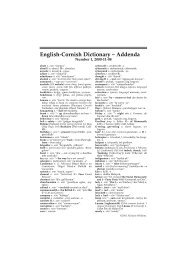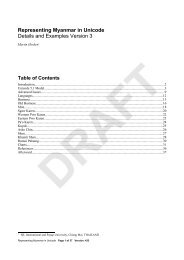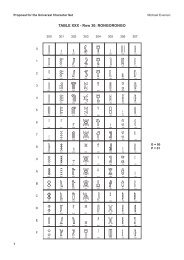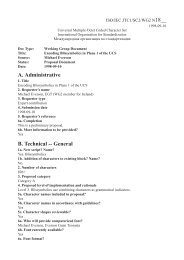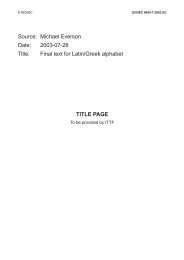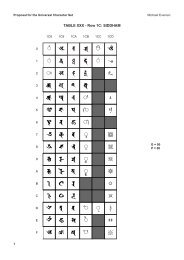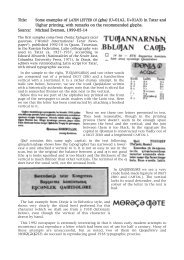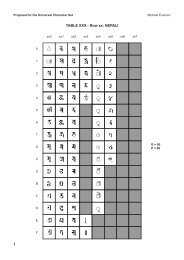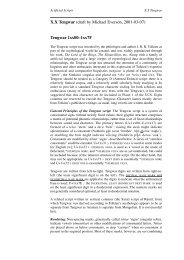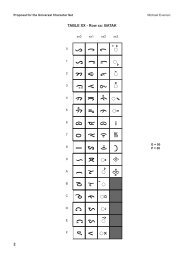ISO/IEC JTC1/SC2/WG2 N3xxx L2/07-xxx - Evertype
ISO/IEC JTC1/SC2/WG2 N3xxx L2/07-xxx - Evertype
ISO/IEC JTC1/SC2/WG2 N3xxx L2/07-xxx - Evertype
Create successful ePaper yourself
Turn your PDF publications into a flip-book with our unique Google optimized e-Paper software.
7.1. Entities to which Gardiner gave specific catalogue numbers. Most of these are taken quite<br />
straightforwardly from the sign-lists. A few characters which need additional comment are discussed<br />
here. Gardiner gave catalogue numbers to Ô C002B, ı C002C, Ò C013, and Ú C015. C002B was used in<br />
the royal name ’ Sth ¯ nh ˘ t mrr ìmn RÆ ‘Setnakht beloved of Amun Ra’, attested in the<br />
Topographical Bibliography (Vol. I, Pt. II, p. 527). It can be argued that reversed characters like these<br />
should not be encoded because Manual de Codage markup is normally used for reversing and rotating<br />
characters. This is not always the case of course. Û D054 ‘movement’ contrasts with Ù D055<br />
‘backwards’; ı P001 ‘boat’ contrasts with ˆ P001A as used in ~ˆ pnÆ ‘upset, overturn’. Some<br />
other characters are distinguished as “low” glyphs needed in Gardiner’s font: compare ˜ E034 and<br />
¯ E034A, Ï F013 and Ì F013A, ˘ G036 and ˙ G036A, ˚ G037 and ¸ G037A, Ê N025 and<br />
Á N025A, Ë V030 and È V030A, and Í W003 and Î W003A. Egyptologists are not unanimous as<br />
to the need to use these variants as characters per se, but a number of them requested the retention in the<br />
character set for completeness of representation of Gardiner’s own materials. In a certain sense they may<br />
be considered “compatibility” characters.<br />
7.2. Positional variants without Gardiner catalogue numbers. A number of positional variants without<br />
catalogue numbers were listed in the Gardiner 1957 and Gardiner 1928. An example is the down-facing<br />
fly Å, which is arguably an error occurring only in the Index to Gardiner’s sign-list; Ä L003 seems to be<br />
the only form found elsewhere. Other examples are the two moons É and Ö which are said by Gardiner to<br />
be used as determinatives; but Ç N011 and Ñ N012 can represent these well enough. Twenty-six such<br />
variants were listed in a code table in N3183 described as “Gardiner Positional Variants”. The<br />
Egyptologists we consulted considered it unnecessary that these be encoded, apart from three of them.<br />
Vertical á O029A (a variant of Ü O029) and â Y001A (a variant of à Y001) were requested by more<br />
than one specialist because of their very high frequency of occurence. The vertical F045A Ü used in<br />
hieratic for m, n was identified by Gardiner as a vertical form of á rth. ‘restrain’ but it has been shown<br />
to derive from F045 à BICORNUATE UTERUS OF HEIFER, and so the two should not be unified.<br />
7.3. Enclosures. The two principal names of the king, the nomen and praenomen, were normally written<br />
inside a cartouche: a figure representing a coil of rope, for instance “ ≠¨pp ‘Apophis’. Gardiner<br />
1957:71–76 describes the royal titulary, giving beginning and end shapes œ and — signs in the Catalogue.<br />
The bracket-like convention of writing œ–— is used in the hieratic (cf. Möller 1936:51) and some<br />
modern publications. Plain text and general purpose software should likewise treat these signs as<br />
characters and not render the fully enclosed form. Several other characters are also used to represent<br />
enclosures. While the cartouche proper normally begins with œ V011A and ends with — V011B, it<br />
sometimes ends with ” V011C, the “knotless” cartouche. The h. wt enclosure used to describe houses,<br />
temples, and tombs is based on ‹ O006, the rectangular enclosure seen in plan. It may have different<br />
beginning and final forms. When ‘ O006A begins a h. wt enclosure, ÿ O006D or Ÿ O006E may complete<br />
it; when ÷ O006B or ◊ O006C begins a h. wt enclosure, ⁄ O006F may complete it. The srh ˘ or serekh<br />
enclosure is based on € O033, a banner. A serekh enclosure is begun with ‘ O006A, and completed with<br />
’ O033A. Champollion 1836:159 describes a “fortified surrounding wall” cartouche based on â O033,<br />
the fortifed wall, which is used to describe countries and foreign cities; this begins with ä O033A and<br />
ends with ã O033B. A rectilinear form of this is also given in Champollion 1841–43:274; this begins<br />
with å O033C and ends with ç O033D.<br />
7.4. Numerals. Egyptian numbers are encoded here along the same principles which were used in the<br />
encoding of Aegean and Cuneiform numbers. Gardiner does not supply a full set of numerals with<br />
catalogue numbers in his Egyptian Grammar. He describes numbers in detail in §§259–266. Möller’s<br />
three volumes on Hieratic palaeography do give catalogue numbers and those references have been added<br />
to the database to instantiate the numerals encoded. Two conventions of representing Egyptian numerals<br />
4





